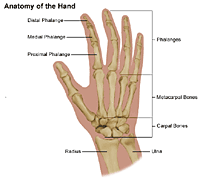Bones In Hands And Feet
Anatomy of the Paw
Anatomy of the Paw
The paw is composed of many dissimilar bones, muscles, and ligaments that allow for a large amount of movement and dexterity. There are 3 major types of basic in the manus itself, including:

-
Phalanges. The 14 basic that are found in the fingers of each hand and besides in the toes of each human foot. Each finger has three phalanges (the distal, eye, and proximal); the thumb only has 2.
-
Metacarpal bones. The 5 bones that compose the middle office of the hand.
-
Carpal bones. The 8 bones that create the wrist. The two rows of carpal basic are connected to two basic of the arm--the ulna bone and the radius os.
Numerous muscles, ligaments, tendons, and sheaths tin can exist plant within the hand. The muscles are the structures that can contract, allowing movement of the basic in the hand. The ligaments are fibrous tissues that help bind together the joints in the hand. The sheaths are tubular structures that environs function of the fingers. The tendons connect muscles in the arm or hand to the os to allow motility.
In addition, at that place are arteries, veins and nerves inside the manus that provide blood flow and sensation to the paw and fingers.
Bones In Hands And Feet,
Source: https://www.hopkinsmedicine.org/health/treatment-tests-and-therapies/anatomy-of-the-hand
Posted by: petersonwhichoune.blogspot.com


0 Response to "Bones In Hands And Feet"
Post a Comment